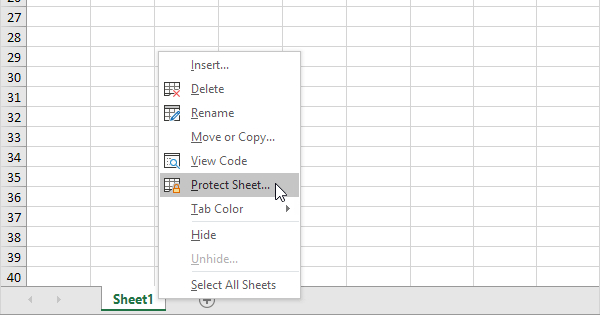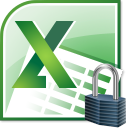Protect Excel 2007 Sheet with Password Easily

In today's data-driven world, ensuring the security and integrity of your Microsoft Excel 2007 spreadsheets is paramount. Whether you're dealing with financial data, employee records, or other sensitive information, you'll want to protect your Excel sheets from unauthorized access. This blog post will guide you through the steps to secure your Excel 2007 worksheet with a password, making it an indispensable skill for office professionals, business owners, and anyone who deals with confidential data.
Understanding Excel 2007 Sheet Protection

Excel 2007 offers several layers of protection:
- Workbook Protection: Prevents changes to the structure of the workbook, such as adding, deleting, hiding, or un-hiding sheets.
- Worksheet Protection: Restricts modifications within individual sheets, allowing control over cell editing, formatting, and structure.
- Password Encryption: Adds an extra layer of security by requiring a password to open or modify the file.
Step-by-Step Guide to Password Protecting an Excel Sheet

Here’s how to easily protect your Excel 2007 sheet with a password:
Open Excel and Select the Sheet

Begin by opening your Excel file. Navigate to the worksheet you want to secure by clicking on its tab at the bottom of the Excel window.
Access the Protection Menu

Go to the Review tab on the Ribbon. This tab contains all the tools needed for document review and security features.
Password Protect the Sheet

- Click on “Protect Sheet” in the “Changes” group.
- In the dialog box that appears, check the boxes next to the actions you want to allow when the sheet is protected. For example, allow users to format cells, format columns and rows, or insert hyperlinks.
- Enter a password in the “Password to unprotect sheet” field. Remember, Excel 2007 is case-sensitive when it comes to passwords.
- Confirm the password by re-entering it in the following dialog box.
- Click “OK” to set the protection.
🔒 Note: Be sure to choose a strong password. A combination of letters, numbers, and symbols will provide the best security.
Testing Your Protection

To ensure the protection is in place, try making a change to the protected sheet. Excel should prompt you for the password. Enter the password you’ve set to temporarily unprotect the sheet, make changes, then reprotect it.
| Feature | Permission | Action |
|---|---|---|
| Select locked cells | Allowed | Users can select locked cells to see their contents but cannot edit them. |
| Select unlocked cells | Allowed | Users can edit only the cells you've left unlocked. |
| Format cells | Not Allowed | Prevents changes to cell formatting unless explicitly allowed. |
| Insert columns | Not Allowed | Blocks the ability to add columns. |

Managing and Removing Sheet Protection

Over time, you might need to adjust or remove the protection:
- To modify the sheet protection settings: Follow the same steps as above and enter the password when prompted.
- To remove sheet protection: Go to the “Review” tab, click “Unprotect Sheet,” enter the password, and the protection will be lifted.
💡 Note: When protecting sheets for collaborative work, consider leaving some cells unprotected for user input.
Alternative Methods for Sheet Security

While password protection is standard, here are additional ways to secure your Excel data:
- Read-Only Mode: Open your workbook and select “Save As.” In the “Tools” dropdown at the bottom, choose “General Options” to make the file read-only.
- User-Level Permissions: Use Windows rights management or third-party tools to apply user-specific permissions.
- Locking Formulas: Hide formulas from view and protect cells containing sensitive formulas.
All these methods provide different layers of security, allowing you to choose the level of protection that fits your specific needs.
Increasing Excel Security

To further bolster your Excel security:
- Regularly backup your Excel files to prevent data loss.
- Utilize the ‘Share Workbook’ feature for collaborative work while maintaining some level of control.
- Disable macros in Excel to prevent execution of potentially harmful scripts.
🔧 Note: Remember, while Excel 2007 offers basic security features, more advanced options are available in newer versions like Excel 2010 and above.
By following the steps and understanding the methods outlined above, you can secure your Excel 2007 spreadsheets effectively. Protecting your data with password protection ensures that only authorized personnel can access or modify your sensitive information, keeping your business operations smooth, efficient, and secure.
What happens if I forget the password?

+
Unfortunately, if you forget the password, there is no built-in recovery method in Excel 2007. You might need to use third-party software to crack or reset the password, or you’ll have to recreate the sheet.
Can I protect multiple sheets at once?

+
Excel 2007 doesn’t support protecting multiple sheets simultaneously. You must protect each sheet individually.
Is Excel protection foolproof?

+
Excel protection is useful for preventing accidental changes or unauthorized access by casual users. However, it is not foolproof against determined attempts to bypass it, especially by users with advanced technical skills.